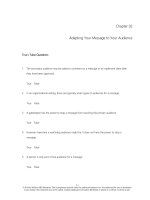Business communication building critical skill 3rd by locker module 20
Bạn đang xem bản rút gọn của tài liệu. Xem và tải ngay bản đầy đủ của tài liệu tại đây (361.38 KB, 11 trang )
PPT
PPT
Module
Module 20
20
Making
MakingOral
Oral
Presentations
Presentations
McGraw-Hill/Irwin
©2007, The McGraw-Hill Companies, All Rights
20-2
Making
Making Oral
Oral Presentations
Presentations
To learn how to
Turn material from a paper
document into a presentation.
Plan and deliver oral presentations.
Develop a good speaking voice.
Give group presentations.
20-3
Making
Making Oral
Oral Presentations
Presentations
Start by answering these questions:
What decisions do I need to make as
I plan a presentation?
How should I organize a
presentation?
How can I create a strong opener and
close?
20-4
Making
Making Oral
Oral Presentations
Presentations
Start by answering these questions:
What are the keys to delivering an
effective presentation?
How should I handle questions from
the audience?
What are the guidelines for group
presentations?
20-5
Purposes
Purposes of
of Oral
Oral Presentations
Presentations
Informative Presentations
Inform or teach the audience.
Persuasive Presentations
Motivate the audience to act.
Goodwill Presentations
Entertain and validate the audience.
20-6
To
To Plan
Plan aa Presentation,
Presentation, Choose
Choose
Your main point.
The kind of presentation.
Monologue
Guided
Sales
Ways to involve the audience.
20-7
To
To Create
Create and
and Show
Show Visuals
Visuals
Make one main point
per visual.
Give each visual a
title.
Limit information to
35 words or less.
Don’t put your visual
up until you’re ready
to talk about it.
20-8
Strong
Strong Openers
Openers May
May Use
Use
A startling statement.
A narration or anecdote.
A question.
A quotation.
An overview of the main points
immediately after the opener.
20-9
Strong
Strong Closes
Closes May
May
Restate your main point.
Refer to your opener.
End with a vivid, positive picture.
Tell the audience exactly what to
do to solve the problem you’ve
discussed.
2010
Patterns
Patterns of
of Organization
Organization
Chronological
Problem-Causes-Solution
Excluding Alternatives
Pro-Con
1-2-3
To
To Deliver
Deliver an
an Effective
Effective
Presentation
Presentation
Transform fear.
Use eye contact.
Stand and gesture effectively.
Use notes and visuals.
Anticipate questions.
2011









